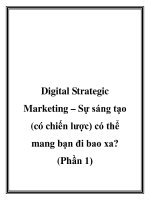Chap 2 strategic marketing
Bạn đang xem bản rút gọn của tài liệu. Xem và tải ngay bản đầy đủ của tài liệu tại đây (322.8 KB, 13 trang )
Chapter 2
Strategic Marketing
A. Intoduction
1. Marketing’s Role in the Organization (TM 2-1)
2. Definition of Marketing Strategy (TM 2-2)
3. Characteristics of Strategic Marketing (TM 2-3)
B. Marketing Strategy Formulation
1. Three Strategic Cs (TM 2-4)
2. Key Elements of Marketing Strategy Formulation (TM 2-5)
3. Strategic Marketing Decisions (TM 2-6)
4. Test of a Good Marketing Strategy (TM 2-7)
5. Future of Strategic Marketing (TM 2-8)
C. Strategic Marketing and Marketing Management
1. Major Differences Between Strategic Marketing and Marketing Management (TM 2-9)
D. Organizational Context of Strategic Marketing
1. Profess of Strategic Marketing (TM 2-10)
E. Strategic Marketing Implementation
1. Failings in Strategic Marketing (TM 2-11)
2. Addressing the Failings (TM 2-12)
169
170 CHAPTER 2: Strategic Marketing
2-1
MARKETING’S ROLE
IN THE ORGANIZATION
ORGANIZATIONAL
ROLE OF
FORMAL
LEVEL
MARKETING
NAME
Corporate
Provide customer and
Corporate
competitive perspective for
marketing
corporate strategic planning
Business Unit
Assist in the development of
Strategic
strategic perspective of the
marketing
business unit to direct its future
course
Product/market
Formulate and implement
marketing programs
Marketing
management
CHAPTER 2: Strategic Marketing 171
2-2
DEFINITION OF
MARKETING STRATEGY
Marketing strategy is an endeavor by a business
unit to differentiate itself positively from its
competitors, using its relative corporate strengths
to better satisfy customer needs, in a given
environmental setting.
172 CHAPTER 2: Strategic Marketing
2-3
CHARACTERISTICS OF
STRATEGIC MARKETING
• Emphasis on long-term implications.
• Corporate inputs.
• Varying roles for different products/markets.
• Organizational level.
• Relationship to finance.
CHAPTER 2: Strategic Marketing 173
2-4
3 STRATEGIC Cs
•
Customer
•
Corporation
•
Competition
174 CHAPTER 2: Strategic Marketing
2-5
KEY ELEMENTS OF MARKETING
STRATEGY FORMULATION
CHAPTER 2: Strategic Marketing 175
2-6
STRATEGIC MARKETING DECISIONS
• Where to compete—i.e., definition of the market.
• How to compete—i.e., means for competing.
• When to compete—i.e., timing of market entry.
176 CHAPTER 2: Strategic Marketing
2-7
TEST OF A GOOD
MARKETING STRATEGY
• A clear market definition.
• A good match between corporate strengths and the
needs of the market.
• Superior performance, relative to competition, in the
key success factors of the business.
.
CHAPTER 2: Strategic Marketing 177
2-8
FUTURE OF STRATEGIC MARKETING
Strategic marketing is increasingly becoming
important because of:
• Battle for market share.
• Deregulation in many industries.
• Packaged-goods companies entering nonmarketingoriented industries.
• Shifts in channel structure.
• Competition from overseas.
• Fragmentation of markets.
• Getting to the market quickly.
• Conceive and create new and uncontested market
spaces.
• Demographic shift in American society.
178 CHAPTER 2: Strategic Marketing
2-9
MAJOR DIFFERENCES BETWEEN
STRATEGIC MARKETING AND MARKETING
MANAGEMENT
POINT OF
DIFFRENCE
STRATEGIC
MARKETING
MARKETING
MANAGEMENT
Time frame
Long-range; i.e., decisions
have long-term implications
Day-to-day, i.e., decisions
have relevance in a given
financial year
Orientation
Inductive and intuitive
Deductive and analytical
Decision process
Primarily bottom-up
Mainly top-down
Relationship
with environment
Environment considered ever- Environment considered
changing and dynamic
constant with occasional
disturbances
Opportunity
sensitivity
Ongoing to seek new
opportunities
Ad hoc search for a new
opportunity
Organizational
behavior
Achieves synergy between
different components of the
organization, both
horizontally and vertically
Pursues interests of the
decentralized unit
Nature of job
Requires high degree of
creativity and originality
Requires maturity,
experience, and control
orientation
Leadership style
Requires proactive
perspective
Requires reactive
perspective
Mission
Deals with what business to
emphasize
Deals with running a
delineated business
CHAPTER 2: Strategic Marketing 179
2-10
180 CHAPTER 2: Strategic Marketing
2-11
FAILINGS IN STRATEGIC MARKETING
• Too much emphasis on “where” to compete
and not enough on “how” to compete.
• Too little focus on uniqueness and adaptability
in strategy.
• Inadequate emphasis on “when” to compete.
CHAPTER 2: Strategic Marketing 181
2-12
ADDRESSING THE FAILINGS
• Develop attainable goals and objectives.
• Involve key operating personnel.
• Avoid becoming engrossed in current problems that
may affect strategic planning.
• Don’t keep marketing strategy separate from the rest
of management process.
• Avoid formality in strategy formulation.
• Create climate conducive to strategic planning.
• Avoid delegating strategy development to a planner.
• Avoid intuitive and conflicting decisions.









